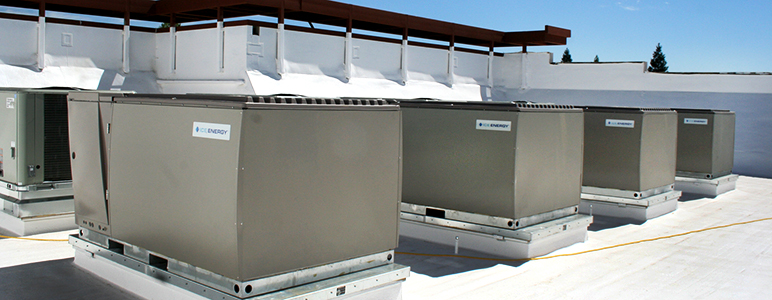


Presented at the American Council for an Energy-Efficient Economy Conference, Aug. 21-26, 2016 - View Presentation
Small thermal energy storage (TES) systems are opening a new frontier in electrical use and power grid management. Once just for larger commercial use, compact, prepackaged, plug-and-play TES systems are now available for smaller applications, providing significant financial benefits for businesses and reducing energy demand on the grid while curbing greenhouse emissions from fossil-fuel sources. The Center for Sustainable Energy has been instrumental in supporting TES as an eligible technology in California’s Self-Generation Incentive Program (SGIP).
As a first step, take CSE’s Clean Energy Assessment.
We assist in evaluating business energy needs and opportunities for applying TES and a wide range of clean energy solutions.
Basically, TES systems make ice at night when electricity costs are the lowest. Throughout the day, when on-site HVAC or refrigeration systems would typically operate and consume large amounts of peak-hour electricity, the TES system turns off the existing system’s compressors and condensers. The stored ice is then used to provide space conditioning or refrigeration by running lower-consuming pumps and fans.
While TES systems provide financial benefits to businesses, they also can help provide a mechanism for stabilizing electric transmission and distribution grids by improving efficiency, reducing peak generation and avoiding costly grid infrastructure upgrades. Strategically locating TES resources in constrained or otherwise critical grid areas provides a way for utilities to reduce peak power demands, particularly during hot days when up to half of the load can come from air conditioning.
Northeast peak load reductions
Utilities in Maine are currently using TES as part of a suite of technologies to reduce peak load to save customers money. The project, which costs $6 million, is deferring the need to upgrade a transmission line at the cost of $18 million, resulting in a three-year payback and saving ratepayers $12 million over the next three years.
Similarly, Massachusetts and New York utilities are proposing to use TES as a cost-effective way to reduce summer HVAC loads and year-round refrigeration loads.
On Nantucket Island, the local utility proposes to include 2.5 MW of TES integrated with residential air conditioning along with other energy-reducing measures to accommodate projected increased demand, which will put off the need to build a new undersea transmission line and save an estimated $2.8 million over the next seven years.
In the New York City boroughs of Brooklyn and Queens, the local utility is placing refrigeration-integrated TES systems at approximately 15 supermarkets, totaling 1.5 MW of load reduction capacity. It is part of a large program aimed at preventing grid overload projected during the summers of 2017 and 2018 by increasing the system’s demand response capabilities.
Southern California environmental benefits
Small TES also can provide environmental benefits by reducing greenhouse gas and criteria air pollutant emissions. On the 12 hottest days of summer 2015, Southern California Edison called on customers to reduce peak demand in order to relieve stress on the grid.
An aggregated 1 megawatt of small TES systems was successful in offsetting the need to generate 32 megawatt-hours of electricity that would have otherwise been supplied by natural gas-fired generators. Reducing peak demand via TES during these 12 days reduced carbon dioxide emissions by 19 tons and nitrous oxide emissions by 2.6 pounds – the equivalent of removing 112 passenger vehicles from the road during the period.
Making the connection
Surprisingly, the benefits of TES are not widely known, and even in green buildings, the technology is uncommon. Yet there are huge opportunities for TES as an energy-management strategy as the nation’s utility grid is modernized and a smart grid emerges. And with the development of improved, compact systems and the recognition by utilities of the grid benefits of TES, the technology is likely to grow and become even more important.
In California, the SGIP offers incentives for eligible TES systems. To further reduce upfront costs, businesses can use property assessed clean energy (PACE) financing or other green lending options.

